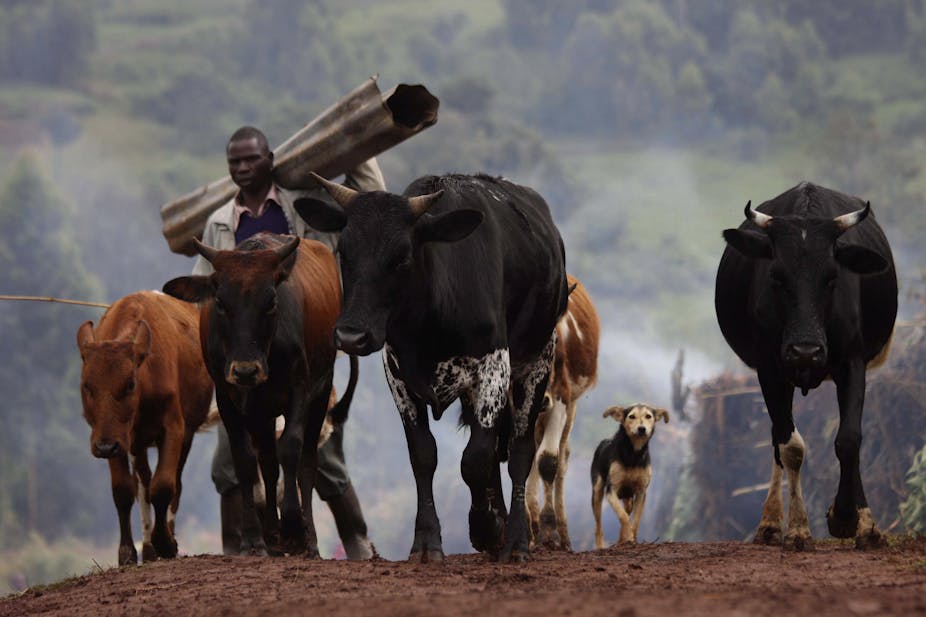-Most people in the world never see the inside of a slaughterhouse. This is true in Kenya where concerns have been raised about the health risks associated with slaughterhouses, particularly in rural parts of the country. The Conversation Africa’s Health and Medicine Editor Joy Wanja Muraya spoke to Veterinary Epidemiologist Elizabeth Cook about the condition of slaughterhouses in rural Kenya and the risks they pose to public health.
What are the working conditions and practices in rural Kenya’s slaughterhouses?
Research we conducted in western Kenya in the Lake Victoria Basin area bordering Uganda showed that most slaughterhouses had poor working conditions and practices.
We interviewed 738 workers in 142 slaughterhouses in Busia, Bungoma, Kakamega and Siaya counties. Slaughterhouses were located close to market centres where animals could be transported by foot or bicycle and meat supplied to the surrounding area. The facilities were small with an average of seven workers and had low throughput, slaughtering an average of five animals per week.
The majority of slaughterhouses lacked adequate infrastructure. Almost a third of buildings didn’t have a roof. Workers and carcasses were exposed to the sun, rain and other elements. Only four slaughterhouses had piped water, suggesting these facilities were not effectively cleaned.
Almost half the slaughterhouses didn’t have appropriate sanitation amenities, such as latrines and hand-washing facilities.
Personal hygiene practices among workers were also poor: only half said they wore protective aprons and shoes. Almost 20% admitted to slaughtering sick animals, potentially exposing them and consumers to diseases transmitted from animals to man. These are known as zoonotic diseases. Workers also ate and smoked at the slaughterhouse, which increased the risk of transmitting disease causing germs.
What public health concerns emerged in your study?
The biggest public health concern was the potential spread of disease to people consuming meat. Animals were slaughtered on the ground. This increased the risk of meat being contaminated with faecal pathogens such as E. coli, Salmonella and Campylobacter.
Inspection of the animal before slaughtering was practised at less than 10% of slaughterhouses. Sick animals weren’t removed from the slaughter process, increasing the risk of passing on the diseases to the community and placing workers at risk of zoonotic diseases, such as, brucellosis , leptospirosis, and Q fever.
There were also risks associated with sick workers at the slaughterhouses. 10% reported having stomach disorders in the 12 months preceding the survey. Additionally, 4% reported breathing difficulties. When handling carcasses, the workers didn’t wear gloves or masks thus increasing their risk of contracting infections and passing the germs to other people.
Injuries in workers were due to physically strenuous work: for example carcasses were hoisted onto beams using ropes, resulting in about half of the workers complaining of backaches. A quarter reported receiving other injuries at work every month. 8% of workers had a wound at the time of interview.
What are the challenges in adhering to regulations?
The national standards were defined by the Kenyan government in the Meat Control Act of 2012. It calls for proper infrastructure to be put in place, including observing hygiene practices in slaughterhouses. Our study found that slaughterhouses didn’t meet these requirements because of ignorance about the health risks.
Only a third of workers were aware that animals can be a source of disease and less than half of them understood that meat could be a source of disease.
The inadequate facilities and poor infrastructure result from a lack of investment in the industry. The region has a large number of households living on less than a dollar a day. Households can’t afford to purchase animal proteins like meat.
Improving facilities would lead to increased meat prices, which might make this important protein source unaffordable. This might increase the amount of backyard slaughter that cannot be regulated by the veterinary department.
Regulations require that every animal and all meat should be inspected before sale. But we found there was only one inspector for every five slaughterhouses. And they were forced to travel long distances by public transport or motorbike, delaying their ability to inspect the animals.
How can these concerns be addressed? What would be the expected health benefits?
Educating workers, butchers and inspectors about the risks of meat contamination and other health hazards at work is the first step towards improving the public health status of the slaughterhouses.
This would require training in safe food handling practices such as clean removal of the animal’s abdominal contents, appropriate meat storage and hand washing. Workers and inspectors should understand the importance of animal inspection. Inspectors also need to be empowered to enforce regulations.
Investment in infrastructure could lead to phasing out the smaller substandard facilities and focusing on centralised bigger facilities where the economies of scale might keep meat prices from escalating.
But centralising the industry would also require improvements to transport networks and refrigeration for the delivery of meat to remote areas.
Mechanisation could resolve some of the challenges related to carcass handling and reduce the physical strain on workers.
A One Health approach to disease surveillance could be implemented to monitor zoonotic diseases in slaughterhouses. Public health workers should be made aware of the potential for slaughterhouse workers to be sentinels of diseases in animals and people.
Monitoring slaughterhouse workers might be a cost effective method of detecting diseases that are transmitted from animals to man.
Improvements to the meat industry could improve occupational and food safety in the region.

